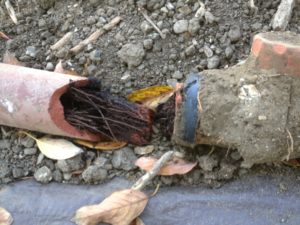
When it comes to planting trees and shrubs around our homes, we generally follow the rule of “what looks nice,” but planter beware! What may look like a great place to plant that lovely new eucalyptus tree outside of your home, may just be the planting ground for future disaster! Root intrusion from trees and plants alike is one of the most devastating and costly issues when it comes to home sewer systems. Don’t put your home’s sewer system in jeopardy, plant safely! Let us get you started!
First, it is important to know what your sewer lateral is and where it is located. Your sewer lateral is the lateral sewer line that runs from your home/property to your city’s sewer main (the large pipes that generally run under the street). Maintenance of this lateral line is more often than not the homeowner’s responsibility. Blockage, or a break in the line, can be awful news. This will cause the waste flowing away from your home to slow, or to completely stop, and begin to back up. (Not a pretty picture!) Tree and plant roots are one of the top 3 causes of sewer line blockages and backups.
Your sewer line is constantly flowing with water and other nutrients that are extremely appetizing to tree and plant roots. Over the years, shifts in the soil around your home cause small, often minuscule cracks in your sewer lateral pipes, which cause tiny leaks or drips of water to seep into the soil surrounding the pipes. Roots seek out this moisture in the soil, and once they locate it, they infest themselves and begin to grow right into the pipe itself. (Note: During hot summer months roots are always in search of water; In cold winter months, they’re in search of warmth). So, tiny, hair-like roots, branch off, twisting, twirling and mangling themselves with the debris flowing from your home. This causes major blockages that back up your home sewer system, and as these roots grow and expand, they often cause these pipes to break and completely collapse, costing the homeowner thousands of dollars to fix. So let’s learn how to plant safely!
- Before planting any new trees, shrubs, or other plants around your home, locate where your sewer lateral line connects to your city’s mainline. This location is often marked with an “S” (for sewer) above ground, where your property line and the street meet. Often it is on the curb or can be found under an access cover on your property.
- Locate the point where this lateral line leaves your home. Generally, you will only be able to pinpoint this location if your home has a cleanout. A cleanout is a 4” wide pipe with a lid that protrudes a few inches from the ground by your home. It acts as an easy access point for your home if a blockage were to ever occur. Sometimes foliage makes them hard to find, but if your home does not have a cleanout, we definitely recommend getting one installed.
- Once you find both of these points, with your mind, draw an imaginary line between them. Now consider this your “Do Not Plant Here” line. It’s almost as simple as that! Roots can actually travel up to a couple of hundred feet depending on the plant, so learning more about the type of tree or shrub you are planning to plant is just as essential as finding your sewer lateral line. Cal Poly San Luis Obispo has a great Urban Forest Ecosystem Institute which offers an amazing website that deals with tree and plant attributes. Before planting anything near your home, check this site out! It even has an option to check the “root damage potential” of a plant! How simple could we make this for you?
So before you take out those gardening gloves and your shovel, make sure to think first about your planting location and the type of plant you will be planting, and let’s all plant a little safer!
